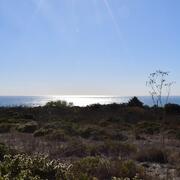Hawaiʻi Abyssal Nodules and Associated Ecosystems Expedition
Defining the Anthropocene via the transport of invasive species
Sediment contaminants in Puget Sound: Implications for ecosystem health and remediation
Seasonal erosion and accretion in a San Francisco Bay marsh
New seafloor mapping offshore Kodiak Island, Alaska, reveals extensive submarine landslides
Land-based nutrient flux to a fringing reef: insights from Ofu Island, American Samoa
Frequency and Intensity of Storm Surges Underestimated Nationally, Study Finds
USGS Coastal Storm Projection Data Inform Department of Defense Infrastructure Risk Assessments
Long-term Satellite Data Reveal How Climate Shapes West Coast Shorelines
Ecological Thresholds, Abiotic Stress, and Climate Change: A Conceptual Framework
Nature-based "Horizontal Levees" Reduce Flood Risk in San Francisco Bay
A 700-year rupture sequence of great eastern Aleutian earthquakes from tsunami evidence and modeling
Pacific Coastal and Marine Science Center
PCMSC is one of three centers serving the mission of the USGS Coastal and Marine Hazards and Resources Program—the primary Federal marine geology and physical science research program responsible for the Nation’s entire coastal and marine landscape.
News
Photo Roundup: August-November 2025
Photo Roundup: August-November 2025
Expedition Recap - Hawaiʻi Abyssal Nodules and Associated Ecosystems
Expedition Recap - Hawaiʻi Abyssal Nodules and Associated Ecosystems
Submarine groundwater discharge cools heat-stressed reefs in Hawai'i
Submarine groundwater discharge cools heat-stressed reefs in Hawai'i
Publications
Comparisons of shoreline positions from satellite-derived and traditional field- and remote-sensing techniques Comparisons of shoreline positions from satellite-derived and traditional field- and remote-sensing techniques
Satellite-derived shorelines (SDS) have the potential to help researchers answer critical coastal science questions and support work to predict coastal change by filling in the spatial and temporal gaps present in current field-based and remote-sensing data collection methods. The U.S. Geological Survey conducted comparison analyses of traditionally sourced shorelines and SDS in diverse...
Groundwater spatial variability within an atoll island: Assessing shallow aquifer heterogeneity with geophysical and physicochemical measurements Groundwater spatial variability within an atoll island: Assessing shallow aquifer heterogeneity with geophysical and physicochemical measurements
This study examines the spatial variability of shallow groundwater on Dhigelaabadhoo Island using electromagnetic induction surveys, groundwater monitoring, and sediment analyses. The research reveals how variations in island morphology—such as differences in elevation, reef flat width, and sediment composition—affect the spatial distribution of groundwater lenses and the overall aquifer...
Impact of warming and suspended terrigenous sediment on the Hawaiian reef coral Montipora capitata Impact of warming and suspended terrigenous sediment on the Hawaiian reef coral Montipora capitata
Coral reefs near high human population areas suffer from sedimentation and increased turbidity due to coastal development. However, there is limited research on how key species respond to turbidity caused by terrigenous sediment and how this response may change with increased water temperatures. This study investigated the effects of ambient and elevated turbidity (+ 26 NTU) in...
Science
USGS research on coastal and nearshore ecosystems informs wildlife and fisheries management
USGS coastal science plays a critical role in supporting the effective, science-based management of coastal ecosystems, where the biodiversity of land and sea meet.
By
Ecosystems Mission Area, Cooperative Research Units, Eastern Ecological Science Center, Forest and Rangeland Ecosystem Science Center, Lower Mississippi-Gulf Water Science Center, Pacific Coastal and Marine Science Center, Western Fisheries Research Center, Western Geographic Science Center, Wetland and Aquatic Research Center
Seafloor Benthic Mapping and Characterization: Enhancing our Understanding of Aleutian Islands’ Hazards, Potential Seabed Minerals and Deep Corals
A USGS-led expedition in the Aleutian Arc off Alaska will provide critical information on energy resources, underwater earthquakes and other hazards, seafloor habitats, and biological resources, including key fisheries, as well as potential seabed minerals.
By
Ecosystems Mission Area, Natural Hazards Mission Area, Coastal and Marine Hazards and Resources Program, Land Management Research Program, Species Management Research Program, Eastern Ecological Science Center, Pacific Coastal and Marine Science Center, St. Petersburg Coastal and Marine Science Center, Wetland and Aquatic Research Center , Woods Hole Coastal and Marine Science Center, Hawaiian Volcano Observatory, Deep Sea Exploration, Mapping and Characterization
Coastal Wetland Vulnerability to Climate Change and Sea-Level Rise: Understanding Ecological Thresholds and Ecosystem Transformations
Eighteen USGS coastal scientists from all four coasts of the conterminous United States are working together to advance the understanding of climate change and sea-level rise impacts to coastal wetlands.
By
California Water Science Center, Chesapeake Bay Activities, Eastern Ecological Science Center, Florence Bascom Geoscience Center, Great Lakes Science Center, Pacific Coastal and Marine Science Center, St. Petersburg Coastal and Marine Science Center, Western Ecological Research Center (WERC), Western Geographic Science Center, Wetland and Aquatic Research Center , Woods Hole Coastal and Marine Science Center






